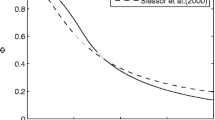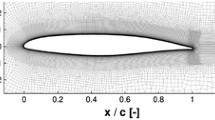Abstract
An intermittency transport equation is developed in this study to model the laminar-turbulence boundary layer transition at supersonic and hypersonic conditions. The model takes into account the effects of different instability modes associated with the variations in Mach numbers. The model equation is based on the intermittency factor γ concept and couples with the well-known SST k–ω eddy-viscosity model in the solution procedures. The particular features of the present model approach are that: (1) the fluctuating kinetic energy k includes the non-turbulent, as well as turbulent fluctuations; (2) the proposed transport equation for the intermittency factor γ triggers the transition onset through a source term; (3) through the introduction of a new length scale normal to wall, the present model employs the local variables only avoiding the use of the integral parameters, like the boundary layer thickness δ, which are often cost-ineffective with the modern CFD methods; (4) in the fully turbulent region, the model retreats to SST model. This model is validated with a number of available experiments on boundary layer transition including the incompressible, supersonic and hypersonic flows past flat plates, straight/flared cones at zero incidences, etc. It is demonstrated that the present model can be successfully applied to the engineering calculations of a variety of aerodynamic flow transition with a reasonably wide range of Mach numbers.
Similar content being viewed by others
References
White, F.M.: Viscous Fluid Flow, 2nd ed. McGraw-Hill, New York, Chap 1 and 7 (1991)
Mack, L.M.: Boundary-layer linear stability theory. AGARD Rept.709 (1986)
Stock, H.W.: e(N) Transition prediction in three-dimensional boundary layers on inclined prolate spheroids. AIAA J. 44, 108–118 (2006)
Menter, F.R., Langtry, R., Völker, S.: Transition modelling for general purpose CFD codes. Flow Turbul. Combust., 77, 277–303 (2006b)
Wilcox, D.: Turbulence Modelling for CFD. La Canada, CA, DCW Industries, Chap 3 (1992)
Savill, A.M.: One-point closures applied to transition. In: Hallbäck, M. (ed.) Turbulence and Transition Modeling, pp. 233–268. Kluwer (1996)
Lardeau, S., Leschziner, M.A., Li, N.: Modelling bypass transition with low-Reynolds-number nonlinear eddy-viscosity closure. Flow Turbul. Combust. 73, 49–76 (2004)
Westin, K.J.A., Henkes, R.A.W.M.: Application of turbulence models to bypass transition. J. Fluids Eng. 119, 859–866 (1997)
Hadžić, I., Hanjalić, K.: Separation-induced transition to turbulence, second-moment closure modeling. Flow Turbul. Combust. 63, 153–173 (2000)
Dhawan, S., Narasimha, R.: Some properties of boundary-layer flow during transition from laminar to turbulent motion. J. Fluid M. 3, 414–436 (1958)
Libby, P.A.: On the prediction of intermittent turbulent flows. J. Fluid Mech. 68, 273–295 (1975)
Steelant, J., Dick, E.: Modelling of bypass transition with conditioned Navier–Stokes equations coupled to an intermittency transport equation. Int. J. Numer. Meth. Fluids 23, 193–220 (1996)
Steelant, J., Dick, E.: Modelling of laminar-turbulent transition for high freestream turbulence. J. Fluids Eng. 123, 22–30 (2001)
Rodi, W.: A review of experimental data of uniform density free turbulent boundary layers. In: Launder, B.E. (ed.) Studies in Convection, vol. 1, pp. 79–165. Academic Press, San Diego (1975)
Byggstoyl, S., Köllmann, W.: Closure model for intermittent turbulent flows. Int. J. Heat Mass Trans. 24, 1811–1823 (1981)
Cho, J.R., Chung, M.K.: A k–ε–γ equation turbulence model. J. Fluid Mech. 237, 301–322 (1992)
Simon, F.F., Stephens, C.A.: Modeling of the heat transfer in bypass transitional boundary-layer flows. NASA Technical Paper 3170 (1991)
Warren, E.S., Hassan, H.A.: Transition closure model for predicting transition onset. J. Aircraft 35, 769–775 (1998)
McDaniel, R.D., Nance, R.P., Hassan, H.A.: Transition onset prediction for high-speed flow. J Spacecr. Rockets 37, 304–309 (2000)
Papp, J.L., Kenzakowski, D.C., Dash, S.M.: Extensions of a rapid engineering approach to modelling hypersonic laminar to turbulent transitional flows. AIAA Paper 2005-0892 (2005)
Schulte, V., Hodson, H.P.: Prediction of the becalmed region for LP turbine profile design. J. Turbomach. (Trans. ASME) 120, 839–845 (1998)
Menter, F.R., Esch, T., Kubacki, S.: Transition modelling based on local variables. In: Rodi, W., Fueyo, N. (eds.) 5th International Symposium on Turbulence Modelling and Measurements. Elsevier (2002)
Menter, F.R., Langtry, R., Likki, S.R., Suzen, Y.B., Huang, P.G., Völker, S.: A correlation based transition model using local variables part 1—model formulation. J. Turbomach. (Trans. ASME) 128, 413–422 (2006)
Langtry, R., Menter, F.R., Likki, S.R., Suzen, Y.B., Huang, P.G., Völker, S.: A correlation based transition model using local variables part 2—test cases and industrial applications. J. Turbomach. (Trans. ASME) 128, 423–434 (2006)
Suzen, Y.B., Huang, P.G., Hultgren, L.S., Ashpis, D.E.: Predictions of separated and transitional boundary layers under low-pressure turbine airfoil conditions using an intermittency transport equation. J. Turbomach. (Trans. ASME) 125, 455–464 (2003)
Pecnik, R., Sanz, W., Gehrer, A., Woisetschläger, J.: Transition modeling using two different intermittency transport equations. Flow Turbul. Combust. 70, 299–323 (2003)
Suzen, Y.B., Huang, P.G.: An intermittency transport equation for modelling flow transition. AIAA paper 2000-0287 (2000)
Lodefier, K., Merci, B., De Langhe, C., Dick, E.: Intermittency based RANS bypass transition Modelling. Prog. Comput. Fluid Dyn. 6, 68–78 (2006)
Mayle, R.E., Schulz, A.: The path to predicting bypass transition. J. Turbomach. (Trans. ASME) 119, 405–411 (1997)
Volino, R.J., Simon, T.W.: Boundary layer transition under high free-stream turbulence and strong acceleration conditions: part 2—turbulent transport results. J. Heat Transfer 119, 427–432 (1997)
Leib, S.J., Wundrow, D.W., Goldstein, M.E.: Effect of free-stream turbulence and other vortical disturbances on a laminar boundary layer. J. Fluid Mech. 380, 169–203 (1999)
Walters, D.K., Leylek, J.H.: A new model for boundary layer transition using a single-point RANS approach. J. Turbomach. (Trans. ASME), 126, 193–202 (2004)
Volino, R.J.: Separated flow transition under simulated low-pressure turbine airfoil conditions—part 1, mean flow and turbulence statistics. J. Turbomach. (Trans. ASME), 124, 645–655 (2002)
Menter, F.R.: Two-equation eddy-viscosity turbulence models for engineering applications. AIAA J. 32, 1598–1605 (1994)
Arnal, D., Casalis, G.: Laminar-turbulent transition prediction in three-dimensional flows. Prog. Aerosp. Sci. 36, 173–191 (2000)
Wilcox, D.: Turbulence Modelling for CFD. La Canada, CA, DCW Industries, Chap 3 (1992)
Medic, G., Durbin, P.A.: Toward improved prediction of heat transfer on turbine blades. J. Turbomach. (Trans. ASME) 124, 187–192 (2002)
Walker, G.J.: Transition flow an axial turbomachine blading. AIAA J. 27, 595–602 (1989)
Savill, A.M.: New strategies in modelling by-pass transition. In: Launder, B.E., Sandham, N.D. (eds.) Closure Strategies for Turbulent and Transitional Flows, pp. 492–521. Cambridge University Press (2002)
Mayle, R.E.: The role of laminar-turbulent transition in gas turbine engines. J. Turbomach. (Trans. ASME) 113, 509–537 (1991)
Sarkar, S., Erlebacher, G., Hussaini, M.Y.: The analysis and modelling of dilatational terms in compressible turbulence. J. Fluid Mech. 227, 473–493 (1991)
Sarkar, S.: The stabilizing effect of compressibility in turbulent shear flow. J. Fluid Mech. 282, 163–186 (1995)
The MathWorks, Natick, M.A.: Using MATLAB version 5, revised for MATLAB 5.1 edition (1997)
Schlichting, H.: Boundary Layer Theory, 7th ed. McGraw-Hill, New York, Chap 15 (1979)
Harris, J.E.: Numerical solution of flow equations for laminar, transitional, and turbulent compressible boundary layers for planar or axisymmetric flows. NASA-TR-R-368 (1971)
Liou, M.S.: A Sequel to AUSM: AUSM+. J. Comput. Phys. 129, 364–382 (1996)
Schubauer, G.B., Klebanoff, P.S.: Contribution on the mechanics of boundary layer transition. NACA TN 3489 (1956)
Mateer, G.G., Monson, D.J., Menter, F.R.: Skin-friction measurements and calculations on a lifting airfoil. AIAA J. 34, 231–236 (1996)
Chen, F.J., Malik, M.R., Beckwith, I.E.: Comparison of boundary-layer transition on a cone and flat plate at Mach 3.5. AIAA J. 27, 687–693 (1989)
Lachowicz, J.T., Chokani, N., Wilkinson, S.P.: Boundary-layer stability measurements in a hypersonic quiet tunnel. AIAA J. 34, 2496–2500 (1996)
Kendall, J.M.: Wind tunnel experiments relating to supersonic and hypersonic boundary-layer transition. AIAA J. 13, 290–299 (1975)
Coles, D.: Measurements of turbulent friction on a smooth flat plate in supersonic flow. J. Aero. Sei. 21, 433–446 (1954)
Deem, R.E., Murphy, J.S.: Flat plate boundary layer transition at hypersonic speeds. AIM Paper 65-128 (1965)
Author information
Authors and Affiliations
Corresponding author
Rights and permissions
About this article
Cite this article
Wang, L., Fu, S. Development of an Intermittency Equation for the Modeling of the Supersonic/Hypersonic Boundary Layer Flow Transition. Flow Turbulence Combust 87, 165–187 (2011). https://doi.org/10.1007/s10494-011-9336-1
Received:
Accepted:
Published:
Issue Date:
DOI: https://doi.org/10.1007/s10494-011-9336-1




